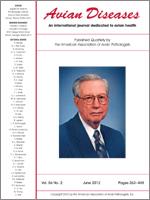BioOne.org will be down briefly for maintenance on 14 May 2025 between 18:00-22:00 Pacific Time US. We apologize for any inconvenience.
Articles (3)
Regular Articles (21)
Research Notes (4)
Case Reports (6)

No abstract available
No abstract available
No abstract available
Improved Broiler Performance Associated with Ornithobacterium rhinotracheale Vaccination in Breeders
No abstract available
No abstract available
